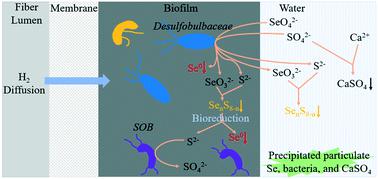当前位置:
X-MOL 学术
›
Environ. Sci.: Water Res. Technol.
›
论文详情
Our official English website, www.x-mol.net, welcomes your feedback! (Note: you will need to create a separate account there.)
Understanding the composition and spatial distribution of biological selenate reduction products for potential selenium recovery
Environmental Science: Water Research & Technology ( IF 5 ) Pub Date : 2020-06-29 , DOI: 10.1039/d0ew00376j Zhiming Zhang 1, 2, 3, 4, 5 , Yi Xiong 1, 2, 3, 4, 5 , Huan Chen 3, 4, 5, 6 , Youneng Tang 1, 2, 3, 4, 5
Environmental Science: Water Research & Technology ( IF 5 ) Pub Date : 2020-06-29 , DOI: 10.1039/d0ew00376j Zhiming Zhang 1, 2, 3, 4, 5 , Yi Xiong 1, 2, 3, 4, 5 , Huan Chen 3, 4, 5, 6 , Youneng Tang 1, 2, 3, 4, 5
Affiliation

|
Selenate is a common contaminant in agricultural drainage from areas with seleniferous soils. Microbes can convert selenate to elemental selenium nanoparticles, which may be recovered as a valuable resource. One challenge in the recovery of selenium from agricultural drainage is the coexistence of sulfate at very high concentrations. Studies have shown that sulfate may inhibit selenate reduction and lead to the precipitation of selenium sulfides, thus hindering the recovery of elemental selenium nanoparticles. It was found in this work that the hydraulic retention time (HRT) determined the effects of sulfate on selenate reduction by controlling the composition and spatial distribution of the selenium products in a H2-based membrane biofilm reactor. At a HRT of 0.28 days, 99% of selenate was reduced to elemental selenium nanoparticles precipitated in the reactor and suspended in effluent, which was desirable for recovery. When the HRT was decreased to 0.14 days or smaller, selenium sulfides became the dominant particulate selenium product in the effluent. Interestingly, elemental selenium was always the dominant particulate selenium product in the biofilm regardless of HRT owing to further biological reduction of selenium sulfides to elemental selenium and sulfide. At HRTs of 0.28 and 0.14 days, famous selenate and selenite reducers such as Rhodocyclaceae (including Azospira oryzae) and Rhizobium sp. were enriched in the biofilm. Decreasing HRT to 0.07 days resulted in electron donor limitation, which further led to the biofilm dominated by Desulfobulbaceae that is well known for its ability to reduce sulfur and selenium oxyanions and the enrichment of sulfide-oxidizing bacteria.
中文翻译:

了解生物硒酸盐还原产品的组成和空间分布,以回收潜在的硒
硒酸盐是含硒土壤地区农业排水中的常见污染物。微生物可以将硒酸盐转化为元素硒纳米颗粒,可以将其回收为宝贵资源。从农业排水中回收硒的挑战之一是非常高浓度硫酸盐的共存。研究表明,硫酸盐可能会抑制硒酸盐的还原并导致硫化硒的沉淀,从而阻碍元素硒纳米颗粒的回收。在这项工作中发现,水力停留时间(HRT)通过控制H 2中硒产物的组成和空间分布来确定硫酸盐对硒酸盐还原的影响。膜生物膜反应器。在0.28天的HRT下,99%的硒酸盐被还原为元素硒纳米颗粒,沉淀在反应器中并悬浮在流出物中,这对于回收是合乎需要的。当HRT降至0.14天或更短时,硫化硒成为废水中主要的颗粒硒产物。有趣的是,元素硒始终是生物膜中占主导地位的颗粒硒产品,而与HRT无关,这归因于硫化硒的进一步生物还原为元素硒和硫化物。在HRT为0.28和0.14天时,著名的硒酸盐和亚硒酸盐还原剂,如红景天科(包括米曲霉)和根瘤菌sp。富含生物膜。将HRT降低至0.07天会导致电子供体受限,从而进一步导致以脱硫鳞茎科为主的生物膜,该生物膜以其还原硫和硒氧阴离子和富集硫化物氧化细菌的能力而闻名。
更新日期:2020-07-31
中文翻译:

了解生物硒酸盐还原产品的组成和空间分布,以回收潜在的硒
硒酸盐是含硒土壤地区农业排水中的常见污染物。微生物可以将硒酸盐转化为元素硒纳米颗粒,可以将其回收为宝贵资源。从农业排水中回收硒的挑战之一是非常高浓度硫酸盐的共存。研究表明,硫酸盐可能会抑制硒酸盐的还原并导致硫化硒的沉淀,从而阻碍元素硒纳米颗粒的回收。在这项工作中发现,水力停留时间(HRT)通过控制H 2中硒产物的组成和空间分布来确定硫酸盐对硒酸盐还原的影响。膜生物膜反应器。在0.28天的HRT下,99%的硒酸盐被还原为元素硒纳米颗粒,沉淀在反应器中并悬浮在流出物中,这对于回收是合乎需要的。当HRT降至0.14天或更短时,硫化硒成为废水中主要的颗粒硒产物。有趣的是,元素硒始终是生物膜中占主导地位的颗粒硒产品,而与HRT无关,这归因于硫化硒的进一步生物还原为元素硒和硫化物。在HRT为0.28和0.14天时,著名的硒酸盐和亚硒酸盐还原剂,如红景天科(包括米曲霉)和根瘤菌sp。富含生物膜。将HRT降低至0.07天会导致电子供体受限,从而进一步导致以脱硫鳞茎科为主的生物膜,该生物膜以其还原硫和硒氧阴离子和富集硫化物氧化细菌的能力而闻名。



























 京公网安备 11010802027423号
京公网安备 11010802027423号